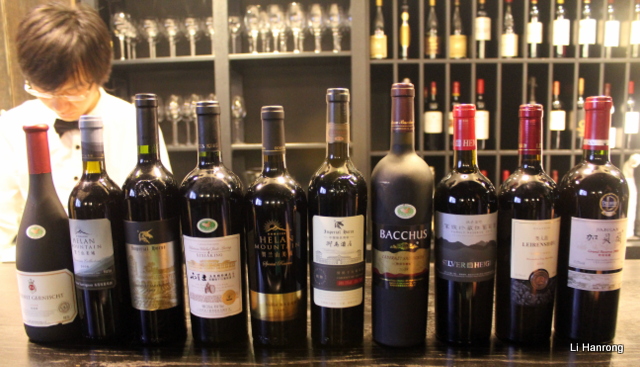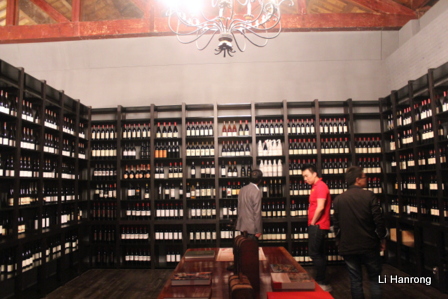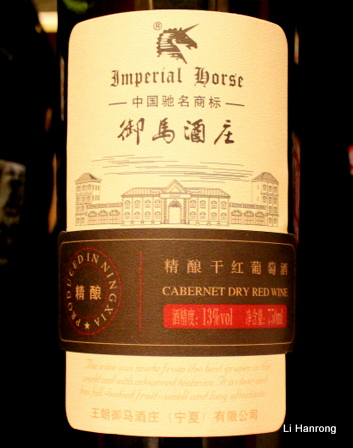Earlier this week, I helped organize a wine contest in Nanjing that included entries from eight operations in Ningxia. I’ll have more details soon, including the results, but first a quick post about the “after taste” — and about which bottles emptied first — at Bar Neuf.
If moved to Beijing, Bar Neuf would rank among the top wine bars in the city. The place is well-organized. The first floor includes a long bar that seats eight, a communal table down the middle, and smaller tables along one side. A standard but efficient setup. Upstairs is a lounge with sofas, a cellar with plenty of trophy wines (Lafite, Petrus et al), and a wine “library” notable for its simplicity – the bottles are neatly arranged on shelves and lit by a chandelier hanging from a high sloped ceiling (see photo below). All good.
But there is plenty of good hardware in China. What Bar Neuf has is the people to match it. Jayson Hu is a key player, involved in both the bar and as an importer. He is a big fan of Rhone Valley wines, is studying for his WSET diploma, and served as a judge in our contest.  On top of this, the bar’s employees are polite and knowledgeable, and several of them speak English. They are not only keen to try wines but also have tasted some of the world’s best, courtesy of Hu. Add on French oysters and Spanish ham, among other food items, and this easily became the top choice to take our extra bottles of Ningxia wine for an “after taste”. Hu agree and we rolled in at ~10 PM with 11 bottles.
Wine contests are fun but so is hanging out and casually drinking with a bunch of writers from all about the country — in this case, Revue du Vin, Wine China, Fine Wine & Liquor and Wine Magazine. Even better, wine maker Emma Gao from Silver Heights, which arguably makes the country’s best wine, joined us.
In these situations, I’m always curious to see which bottles empty first. On this night, it was the Silver Heights Family Reserve that I brought and the bottle of The Summit that Gao brought. Then there was the entry-level bottle of Imperial Horse (see photo below). I included it in the contest based on a blind tasting at Revue du Vin about three weeks ago. Several people had given it good scores and we were surprised to learn it retailed for less than rmb100. In the Nanjing tasting, I again found it simple and fruity, an easy-to-drink wine that we need to see more of made in China.
In terms of the big picture, in past years the discussion would be about whether any of the wines were ‘drinkable’. On this night, we talked more about which ones were best. This is important because it shows an increase in quality and the emergence of a wine region.
I am and have long been a big fan of Grace Vineyard, based in Shanxi, and believe it is the best operation in China. But what he have in Ningxia is a blend of family-owned, state-owned, foreign-invested and medium-sized wineries seeking to improve quality. There are still problems with “value for money”, and with inconsistency, but these operations are pushing each other to be better. Even Grace has a presence in the region.
This is good for the China wine scene and here is hoping the wines continue to improve. All I can say is that at midnight on Wednesday in Nanjing, I was happy to see that lineup of Helan Qing Xue, Bacchus, Xi Xia King, He Quan, Domaine Helan Mountain, Lei Ren Shou, Bacchus, Imperial Horse and Silver Heights, and realize that we are getting more choices when it comes to wine in China.
Grape Wall has no sponsors of advertisers: if you find the content and projects like World Marselan Day worthwhile, please help cover the costs via PayPal, WeChat or Alipay.
Sign up for the free Grape Wall newsletter here. Follow Grape Wall on LinkedIn, Instagram, Facebook and Twitter. And contact Grape Wall via grapewallofchina (at) gmail.com.


